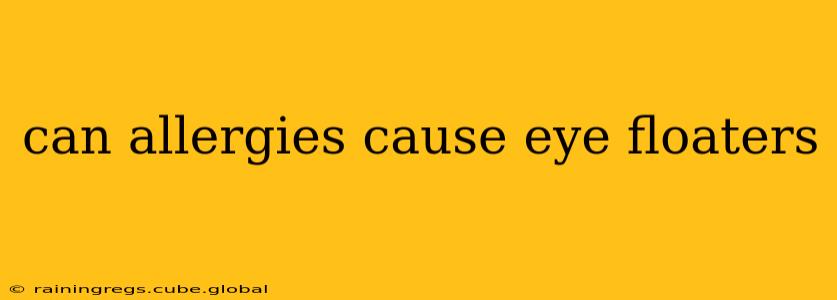Eye floaters—those pesky specks, strands, or cobwebs that drift across your vision—are a common experience. While often harmless, they can be alarming. One question frequently arises: can allergies cause eye floaters? The short answer is: not directly, but allergies can contribute to conditions that indirectly increase the likelihood of experiencing them. Let's delve deeper into this relationship.
What are Eye Floaters?
Before exploring the allergy connection, let's clarify what eye floaters actually are. Floaters are tiny clumps of protein or cells within the vitreous gel, the clear, jelly-like substance that fills the back of your eye. As we age, the vitreous can shrink and become more liquid, allowing these clumps to become more noticeable. They appear to float across your vision because they're moving within the vitreous humor.
Can Allergies Cause Inflammation in the Eye?
Yes. Allergic conjunctivitis, also known as allergic eye disease, is a common condition triggered by allergens like pollen, dust mites, pet dander, and mold. This inflammation can cause a range of symptoms, including:
- Itching: Intense itching around the eyes.
- Redness: Bloodshot or pink eyes.
- Watering: Excessive tearing.
- Swelling: Puffiness around the eyelids.
While this inflammation isn't directly responsible for creating floaters, prolonged and severe inflammation can indirectly affect the vitreous gel.
Can Severe Eye Rubbing (Due to Allergies) Lead to Floaters?
This is a crucial point. The intense itching associated with allergic conjunctivitis often leads to vigorous eye rubbing. Chronic rubbing can:
- Damage the vitreous: The pressure and friction from rubbing can potentially damage the delicate vitreous gel, leading to the formation of more floaters or even a posterior vitreous detachment (PVD). A PVD is when the vitreous detaches from the retina, which can cause a sudden increase in floaters, flashes of light, and in some cases, more serious retinal issues.
- Increase inflammation: Further irritating the eye and prolonging the inflammatory response.
Do Allergies Directly Create the Proteins that Form Floaters?
No. Allergies don't directly produce the proteins or cells that form eye floaters. The presence of allergens themselves doesn't directly translate into a higher concentration of floaters in the vitreous. The link is indirect, via inflammation and the potential for physical damage from eye rubbing.
Are There Other Causes of Eye Floaters Besides Allergies?
Many factors can contribute to eye floaters, including:
- Aging: As mentioned, the vitreous gel naturally liquefies with age, increasing the visibility of floaters.
- Eye injuries: Trauma to the eye can cause bleeding and the formation of floaters.
- Eye diseases: Certain eye conditions like uveitis (inflammation of the uvea) or retinal tears can lead to floaters.
- Diabetes: Diabetic retinopathy can also be a cause.
When Should I See an Eye Doctor About Eye Floaters?
While occasional floaters are usually harmless, you should consult an ophthalmologist if you experience:
- A sudden increase in the number of floaters.
- The appearance of new flashes of light.
- A significant shadow or curtain obscuring your vision.
- Any decrease in vision.
These symptoms could indicate a more serious condition requiring immediate medical attention.
Conclusion: The Indirect Relationship Between Allergies and Eye Floaters
While allergies themselves don't directly cause eye floaters, the inflammation and eye rubbing associated with allergic conjunctivitis can indirectly increase the risk. Managing allergies effectively through appropriate treatment and avoiding excessive eye rubbing are essential in minimizing potential eye complications, including the development of new or worsening eye floaters. Remember, if you're concerned about any changes in your vision, consult with your eye doctor for a proper diagnosis and treatment plan.
